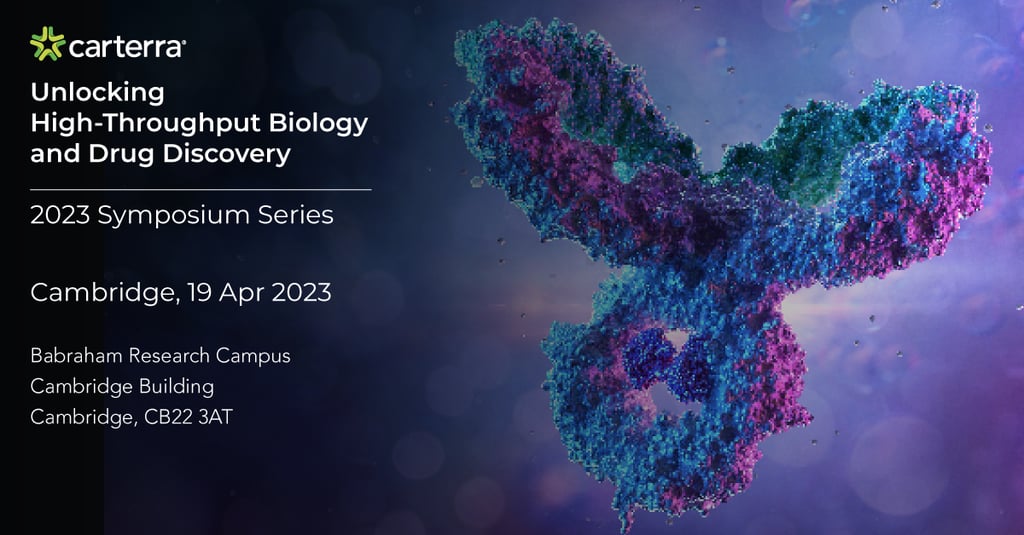
What You Will Learn
Please join Carterra and sponsorship partner, PhenomeX, Inc, at our upcoming symposium in Cambridge, UK. You will spend the day learning about high-throughput drug discovery and antibody therapeutics with some of the industry’s leading scientists. Our speakers will present new ways of looking at discovery, applications, and workflows, including HT-SPR. The topics you'll hear about include:
-
New methods in antibody discovery, DELs and PROTACs
-
Innovations using HT-SPR for drug discovery
-
Challenging assay formats, such as membrane targets and rapid binders
-
Strategies to streamline characterization workflows
-
Best practices in experimental design and analysis
Network with your peers. Lunch will be provided. Registration is required as seating is limited.
Register Here
Agenda |
|
|
8:45 – 9:00 |
Arrive and Check-in |
|
9:00 – 9:30 |
Networking and Coffee/Tea |
|
9:30 – 9:45 |
Symposium Begins—Welcome |
|
9:45 – 10:15 |

Gemma Ottolangui, Investigator, GSK |
| Abstract: In recent years there have been many advances in technology that allow techniques previously limited to small numbers of molecules to be applied to large numbers of samples. Applying such techniques in parallel to the early stages of the antibody discovery process enables determination of high throughput kinetics and biophysical screening of hundreds of antibodies. With higher throughput screening techniques, we need new ways to process, analyse and store our data to enable data re use and machine learning. During this talk I will discuss implementation and application of some of the methods and data workflows which enable characterisation of more molecules with less material and in less time, and give greater breadth of characterisation, to accelerate decision making while improving opportunities for data reuse. | |
|
10:15 – 10:45 |
|
|
|
Abstract: Selection of bi- and tri-specific binders often require the screening of large combinatorial sample sets derived from panels of single domain binders. The Carterra LSA platform makes analyzing the binding properties of these molecules straightforward and requires minimal amounts of mAb sample and antigen. The affinity of the binders to the targets can be measured in several assay formats and used to verify the independence and activity of each binding site for hundreds of clones. Along with the binding kinetics and specificity measurements, the LSA enables large scale epitope binning to ensure diverse sets of clones are being carried forward to functional evaluation. |
|
10:45 – 11:15 |
Break and Networking |
|
11:15 – 11:45 |

Sharandip Nijjar, PhD, Senior Scientist, LifeArc |
| Abstract: At LifeArc we carry out high-throughput antibody screening to discover, characterise and deliver therapeutic monoclonal antibodies. We perform detailed kinetic profiling, epitope specificity, cross reactivity, functional binding and a suite of developability assessment assays to ensure successful downstream development of our lead molecule. We are always looking at ways to innovate our screening platform to ensure we remain at the cutting edge of technology, enabling us to characterise more molecules in a more efficient process. Recently we have purchased the Carterra LSA and here we will share the evolution of our screening platform and how the LSA will enhance our discovery workflow. | |
|
11:45 – 13:00 |
Lunch and Networking |
|
13:00 – 13:30 |

Jordan Barrett, Senior Research Assistant, University of Oxford |
| Abstract: Plasmodium falciparum malaria is a major cause of morbidity and mortality, and new interventions are urgently needed. The P.f reticulocyte-binding protein homolog 5 (PfRH5) antigen is a leading blood-stage vaccine candidate. Vaccines targeting PfRH5 have demonstrated antibody-mediated efficacy in clinical trials, but high, durable titers of antibodies must be induced, a difficult challenge for current generation vaccines. We have generated a panel of >200 anti-PfRH5 monoclonal antibodies from PfRH5-vaccinated UK adults. By using the Carterra LSA platform for HT-epitope binning alongside in vitro functional assays we have revealed the diverse antigenic landscape of PfRH5 and identified inhibitory epitopes to a fine resolution. | |
| 13:30 – 14:00 |
|
| Abstract: The LSAXT expands the capabilities of HT-SPR to meet the demands of challenging assay formats. By building on the established benefits of HT-SPR including more data in less time with less sample, LSAXT has the versatility to address a range of experimental workflows. This talk will highlight how LSAXT is a robust platform for characterization of drug candidates including PROTAC®s and kinase inhibitors. The benefits of enhanced sensitivity and overall data quality in LSAXT take HT-SPR to a whole new level. | |
|
14:00 – 14:30 |
Break and Networking |
|
14:30 – 15:00 |

Lucy Liu, PhD, Senior Director, Head of Global Bioanalytics, Alloy Therapeutics |
| Abstract: In addition to having the desired interaction and mode of action on the target, therapeutic antibodies need to be highly specific. Non-polyspecificity is one of the most important characteristics to have for safety, efficacy, and ideal PK/PD. Since polyspecificity is difficult to get rid of by engineering, assessing it early in the antibody discovery process is crucial. In this study, we developed a new high-throughput HT-SPR-based assay for polyspecificity screening. To validate the assay, we compared it to traditional assays such as ELISA or flow cytometry by using clinical stage antibodies. Where possible, results were correlated to clinical outcomes in literature. This assay is high-throughput and consumes very small amounts of sample, enabling polyspecificity de-risking at an early stage in the discovery process. | |
|
15:00 – 15:30 |

Zara Frizell, PhD, Associate Scientist, Sanofi |
| Abstract: The variable domain of heavy chain-only antibodies from camelids, referred to as NANOBODY molecule, offers numerous advantages for the development of biological drugs. Sanofi Ghent has pioneered the development of this new modality. Following the classical drug development process, one of the most important parameters we are looking at in early screenings is the binding strength of the NANOBODY molecule to its target. This talk will highlight practical aspects and considerations to set up NANOBODY-specific binding assays on the Carterra LSA that have become broadly applicable during lead identification and characterization steps in the Discovery department of Sanofi Ghent. | |
|
15:30 |
Symposium Ends |
 Jon Popplewell, PhD, Field Applications Scientist, Carterra
Jon Popplewell, PhD, Field Applications Scientist, Carterra Noah T. Ditto, Technical Product Manager, Carterra
Noah T. Ditto, Technical Product Manager, Carterra